
The right heart has jokingly been referred to as the organ's stepchild, with little attention paid to its size, function, and prognostic implications. To help with this often overlooked task, this article series will review the proper methods to quantify the right heart for both size and function.
 Andrea Fields, clinical cardiac director at CardioServ.
Andrea Fields, clinical cardiac director at CardioServ.
In this article, we'll share our eight tips for correctly measuring tricuspid annular plane systolic excursion (TAPSE) and the S' wave (tissue Doppler imaging-derived tricuspid lateral annular systolic velocity).
The ASE noted in its 2015 recommendations that RV systolic function should be assessed by at least one or a combination of the following:
- Fractional area change (FAC), S' wave
- TAPSE
- Right ventricular index of myocardial performance (RIMP)
Note that the reference values for these parameters do not provide a mild, moderate, or severe value range. They do not take body surface area (BSA), height, or gender into consideration either. The ASE provides us only with normal and abnormal values.
As a reminder, the ASE suggests using the standard apical 4 (AP4) window when assessing RV function.
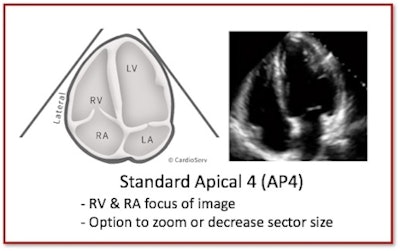 All images courtesy of CardioServ.
All images courtesy of CardioServ.TAPSE
TAPSE is a linear M-mode measurement of the RV longitudinal function. This method offers a widespread and established prognostic value. It has also been validated with global RV function.
TAPSE measurement should be performed by aligning the M-mode cursor parallel to the motion of the lateral tricuspid valve annulus. The annulus should be moving upward toward the apex during systole.
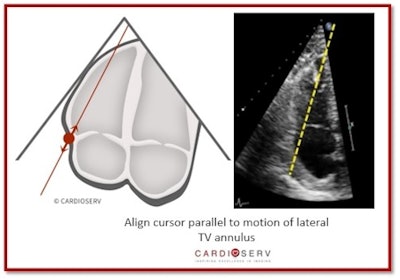
The ultrasound gains should be decreased to avoid measuring noise artifact, and the M-mode sweep speed should be placed at medium-fast. Look for a consistent signal throughout systole and diastole and then identify the maximum systolic and diastolic excursion of annulus motion. Finally, measure vertically using the leading edge-to-leading edge method.
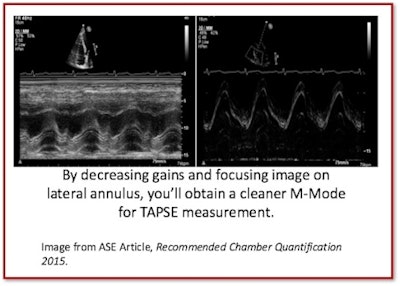
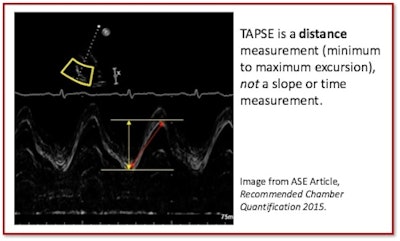
Linear measurements such as these come with some challenges and limitations to be aware of, including angle dependency and the ease of overestimating or underestimating RV function.
It's also important to note that the latest ASE guidelines included changes to the abnormal cutoff reference value for TAPSE. Although acknowledging that there may be minor variations in TAPSE values based on gender and BSA, the ASE's general position now is that a TAPSE value less than 17 mm is highly suggestive of RV dysfunction.
S' wave
The S' wave measures the peak systolic velocity (in cm/sec) of the tricuspid annulus on pulsed-wave tissue Doppler imaging (TDI). This measure is a good indicator of basal (lateral) free-wall function and is easy to perform and reproduce. Offering a similar concept to TAPSE, the S' wave also has an established prognostic value.
S' wave measurement should be obtained by first placing the cursor over the lateral annulus of the tricuspid valve. Pulsed-wave TDI should be performed. As was the case with TAPSE, decrease the ultrasound gains to avoid measuring noise artifact. Then identify the maximum systolic velocity above the baseline to measure the S-wave.
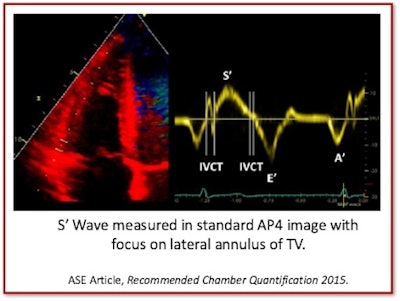
There are also some challenges and limitations to be aware of when measuring the S' wave. This method is an angle-dependent approach that is not fully representative of global RV function. In addition, it's easy to underestimate the S' wave if the Doppler signal is not parallel to the annulus.
There were also some minor changes to the S' wave reference range with the latest ASE guidelines. The society now considers an S' wave value of less than 9.5 cm/sec to indicate RV dysfunction.

Correlate together
It is vital that we make sure to obtain both TAPSE and S' wave values to correlate together. If you are getting an abnormal TAPSE, then you need to make sure your S' wave is demonstrating an abnormal value as well.
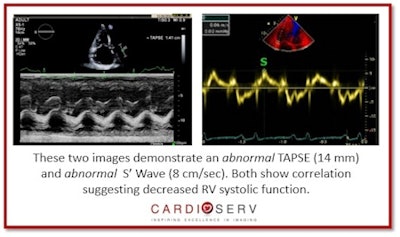
To sum up, here are our eight tips for measuring TAPSE and S' wave:
- Use the standard AP4 view.
- Utilize chamber-focused imaging. We are only interested in the RV and RA!
- Make the cursor parallel to the motion of the annulus.
- Use gain controls to optimize the image.
- Look for a consistent sign for accurate measurement.
- Adjust the sweep speed to elongate waveforms.
- Make sure TAPSE and S' wave correspond correctly to each other; either both should be abnormal or both should be normal!
- Implement both measurements into your normal scanning routine.
The ASE provides us with four great methods for evaluating RV function. If you're not using any method to quantify right heart function, today is the day to start! We at CardioServ suggest using both TAPSE and S' wave. If you are limited to one, S' wave is easily obtained and more reproducible. If you do get an abnormal S' wave, it is ideal to also perform a TAPSE measurement as an additional method to prove the abnormal value. In our next article, we will discuss two other methods -- RIMP and FAC -- that we can use to evaluate right-sided function.
Andrea Fields is the clinical cardiac director at CardioServ. Andrea can be reached by email at [email protected] or via CardioServ's website. You can also connect with her on LinkedIn.
The comments and observations expressed herein do not necessarily reflect the opinions of AuntMinnie.com, nor should they be construed as an endorsement or admonishment of any particular vendor, analyst, industry consultant, or consulting group.



















